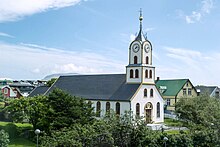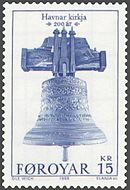Tórshavn Cathedral
The Tórshavn Cathedral ( Faroese Havnar kirkja , pronunciation : [ haunaɹ ʧɪɹʧa ], or Dómkirkjan , pronunciation : [ dɔumˌʧɪɹʧan ]) in the Old Town of Torshavn , the second oldest surviving church is Faroe Islands .
It is a white-painted and slate- covered building that was built in 1788. The cathedral church is located in the north of the Tinganes peninsula and is one of the main attractions of the city. Like most churches in the country, it belongs to the Evangelical Lutheran state church of the Faroe Islands .
Since 1990 it has been the seat of the Bishop of the Faroe Islands. The writer Oddvør Johansen earns her living as an organist here.
prehistory
The prehistory of the church is quite complicated. Apparently there was no real church in Tórshavn in the Middle Ages, at best a “house of prayer”. The service may have been held in the Munkastovan in Tinganes.
It was not until 1609 that a real church was built on a stony hill, called "úti á Reyni", in Tinganes , when King Christian IV commissioned the lord of Bergenhus to "provide the inhabitants of the Faroe Islands with some wood for the construction of their church .." . ".
Rasmus Jørgen Winther became pastor in Tórshavn in 1780, and in 1782 he took the initiative to build a new church. However, this was not completed until 1788 by Johannes Poulsen, the master builder in Tórshavn. The church of Christian IV was demolished after the inauguration of the new church and the wood was auctioned off. Part of the inventory was transferred to the new church.
When the new church was built in 1788, Tórshavn was still so small that it was easy to say that the church was "north of the city". The population of Tórshavn was around 600 in 1788 and around 900 in 1865. Today the church is surrounded by buildings. There is no detailed description or measurement of the church, except for individual drawings and some old photos. From these it can be seen that it looked quite similar to the churches in the villages that were built on the islands during the first half of the 19th century.
English travelers Samuel Rathbone and EH Greig described the church as follows in 1855:
- The church is a large wooden building, in the shape of an English church, with a steeple, equipped with pine wood on the inside and divided into pews and galleries. It has an insignificant image of the crucifixion above the altar and in no way differs from the wooden Lutheran churches in other parts of Northern Europe. This church space was high enough, but Landt writes that some of the churches in the country are so low that a tall man can only stand up between the ceiling beams . ( Wikisource )
The renovation of the church, which was carried out by the Icelandic builder Guðmundur Sigurðsson , called Sivertsen, in 1865, changed the exterior of the church, but only slightly affected the internal structural form of the church from 1788. Overall, the structure is the Church from 1865 has been preserved.
In 1935, however, the choir stalls were lengthened by four meters when a heating system was installed and a new sacristy was built. In 1968 the choir was expanded with an office and other adjoining rooms. There are 44 benches in the nave and 14 on the gallery.
Former altarpiece
On the north wall of the central nave there is an altarpiece (approx. 1647) with a picture of the Lord's Supper . In the uppermost field, the corresponding Pauline word is quoted from 1 Cor 11:26 EU .
In the bottom field is the Danish inscription:
- "Gud Allermechtigste Hans Hellige Ord och Sacramenter Till Ere och denne Steed til Zirat haffuer Hans Sevrensen fordum Kiøbmand her paa Ferøe foraerit denne Altertaffle til Torßhaffns Kiercke 1647".
- (Ger. To honor the Holy Word and the sacraments of God Almighty and to adorn this place, Hans Sevrensen, a former merchant here in the Faroe Islands, gave this altarpiece to the church of Tórshavn in 1647. )
It is a simple work of the late Renaissance . The painting measures 100 by 100 cm and belongs to the religious painting of the 17th century, which was influenced by Peter Candids painting for the Franciscan monastery in Munich ; it was widespread in Northern Europe through the engravings of the Sadeler family . In 1961, the painting was restored by Ernst and Holmer Trier in collaboration with the local painter Fraser Eysturoy .
Ship bell as a church bell
The church bell was probably hung in 1708. It is a ship's bell that was recovered from the wreck of the Norske Løve (Norwegian Lion). The sailing ship of the Danish East India Company , equipped with cannons, sank in Lambavík on New Year's Eve 1707 . The bell is decorated with palmettes and bears the inscription "Danscke Ostindische Compagnies Scheb Nordische Løve 1704" and the gold-plated monogram of the trading company. The height is 30 cm, the lower diameter 41.5 cm.
Individual evidence
- ↑ The article was written with the help of Faroestamps.fo HAVNAR KIRKJA ( Memento from June 3, 2008 in the Internet Archive ).
- ↑ In the English original: “The church is a large wooden edifice, in shape like an English church, with a steeple, fitted inside with pine, and divided into pews and galleries. It has an indifferent picture of the crucifixion over the altar, and is in no respect different from wooden Lutheran churches in other parts of northern Europe. This one was lofty enough; but Landt says some of the country churches are so low, that a tall man can but just stand upright between the rafters. "
Web links
- Havnar Kirkja - Dómkirkjan Folkakirkjan.fo (Faroese)
Coordinates: 62 ° 0 ′ 34.6 " N , 6 ° 46 ′ 18" W.





